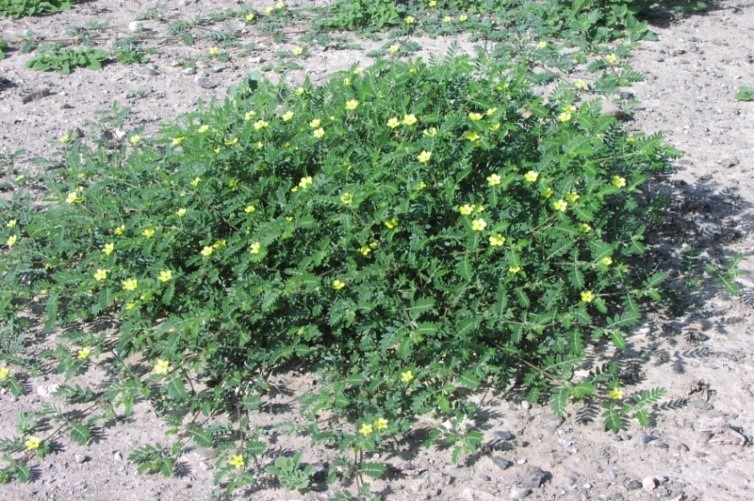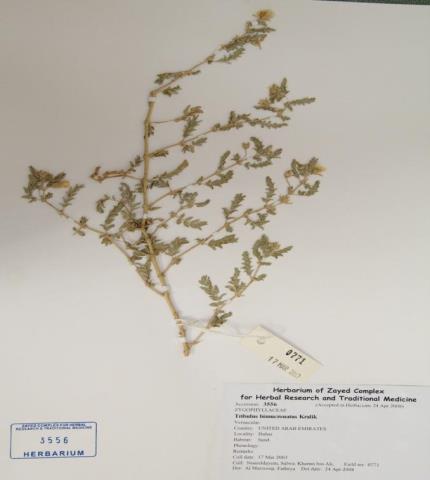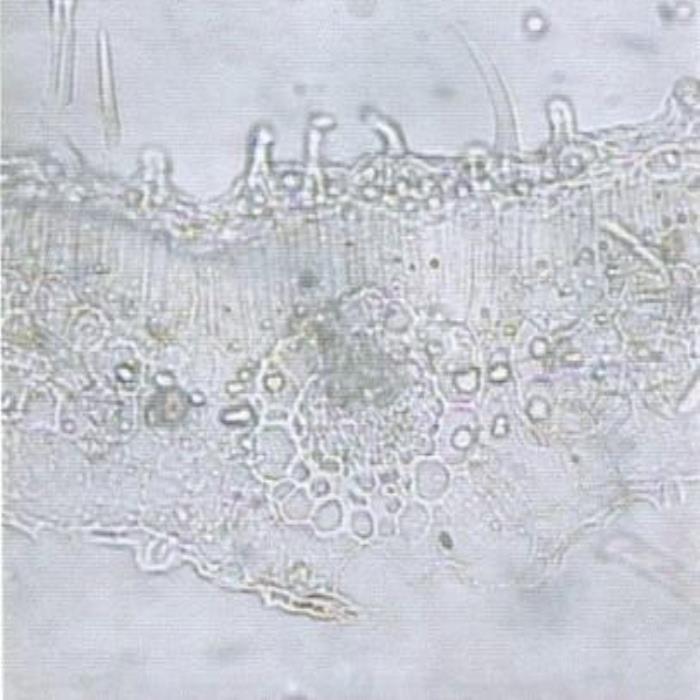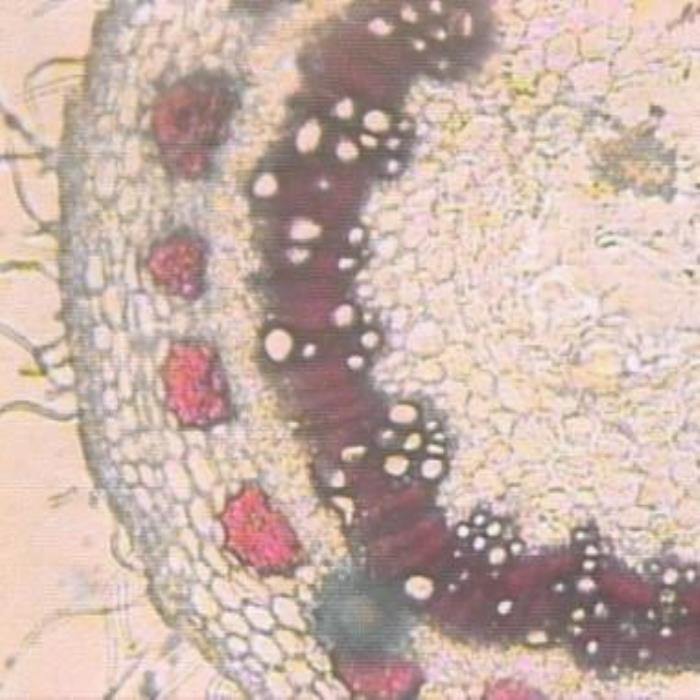
Tribulus terrestris / أبوضريس
Tribulus bicornutus Fisch. & C.A. Mey. Tribulus bimucronatus Kralik, Tribulus saharae A. Chev. Tribulus bispinulosus Kralik, Tribulus intermedius Kralik Tribulusorientalis Kerner, Tribulus robustus Boiss. & Noe Tribulus terrestris var. bicornutus (Fisch. & C.A. Mey). Hadidi Tribulus terrestris var. inermis Boiss. Tribulus terrestris var. robustus (Boiss. & Noe) Boiss.
Qutayb, Abu theras
Bullhead, Burra gokharu, Caltrop, Cat's head, Devil's eyelashes, Devil's thorn, Devil's weed, Goathead, Puncturevine
Qutheb, Abu theras, Hasak
Zygophyllaceae

Flowers

Herbarium specimen
Ethnobotanical Characteristics
Description
It is an annual or biennial, prostrate, densely appressed whitish silky pubescent herb. Stem hirsute to sericeous, branches spreading. Leaves paripinnate, 2.5-5 cm long; stipules lanceolate to falcate, 3-5 mm long; leaflets (4-) 5-6(-8) pairs ovate to elliptic-oblong, 5-10(-12) mm long, 3-8 mm broad, inequilateral, acute. Flowers are yellow, 1-1.5 cm across; pedicel up to 1.5(-2) cm long. Sepals ovate-lanceolate, 5-6 mm long, c. 3 mm broad, acute. Petals obovate, 6-8 mm long, 3-4 mm broad, obtuse. Stamens 10, filamentous c. 3-5 mm long, anthers versatile. Ovary ovoid, hirsute; style c. 1.5 mm long, stigmas decurrent. Fruit up to c. 1 cm in diameter, 4-8 mm long, mericarps densely crested and tuberculate on the dorsal side, densely hairy to glabrescent, with two long patent and two short downwardly directed spines (rarely all or lower 2 reduced to tubercles). (Jongbloed 2003, Flora of Pakistan).
Habitat and Distribution
Tropical and subtropical countries in Asia, Africa, S. Europe, and North Australia and introduced in new world tropics. In the UAE, it is common and widespread in urban areas, roadsides and depressions. (Mandaville, 1990).
Part(s) Used
Whole plant
Traditional and Medicinal Uses
In the UAE, the plant is used by some healers as an aphrodisiac, diuretic and hypotensive and to treat dysuria. It is soothing, analgesic, diuretic, tonic, and acts against colic. The leaves of the plant are used to treat enlarged spleen, puerperal fever, sores, diarrhea, nervous exhaustion and cramps.
Pharmacognosy and Phytochemistry
Plant material Studied
Dried leaflet
General appearance
The leaflet is small in size (up to 12 mm long and 5 mm wide) and grayish green. It shrinks when dried, exposing the lower epidermis outwards. It is brittle and easily broken.
Microscopic characteristics
Leaflet: Both surfaces are covered with dense covering trichomes of different sizes and lengths, which are generally one-celled, conical and tapering. Some of the trichomes have blunt ends, but all have thick cell walls and wide lumens. No glandular trichomes have been detected. In surface view, the cells of both epidermises are observed to be distinctly polygonal and have thick walls; the most characteristic epidermal cells are the basal cells that surround the cicatrices of detached covering trichomes. The oval and anomocytic stomata are equally distributed on both epidermises. The leaflet is unilateral, having one layer of palisade tissues with tightly packed cells underneath the upper epidermis. The spongy mesophyll cells are irregularly shaped and they are tightly packed. Also, the spongy mesophyll contains individual cells with thick cell walls and significant polygonal structures that surround the vascular tissues, of which the most significant are the spirally thickened vessels. Some spongy parenchyma cells contain individual cluster crystals of calcium oxalate with varying sizes; such kinds of cells are generally found near to the vascular tissues. Both palisade and spongy mesophyll cells are rich in tiny coloured particles, and those of the spongy mesophyll contain club-shaped masses.
Plant material Studied
Dried stem and branches
General appearance
The stem and the branches are light grayish-green with a pinkish tint. Branches are thin (1-2 mm in diameter), almost cylindrical in outline but not straight as they change their growing directions in a zigzag form at nodes. They are coarse tomentose touch. They are brittle and tare easily broken. A transverse section of the stem from the periphery to the pith shows the following: an epidermal layer consisting of small ovoid cells with thick cell walls, and the epidermis is covered with thick cuticle. Attached to the epidermis are numerous one-celled covering trichomes that have comparatively wide lumens and thick cell walls. The epidermis encircles several layers of cortical collenchyma (about 6-7 layers); the inner layers enclose groups of lignified fibers that have thick cell walls and narrow lumens. The cortex encircles phloem tissues, heavily lignified xylem tissues (vessels, tracheids and fibers) ,and at the center are the nearly rounded parenchyma cells of the pith, which occupy a wide zone.
Parts studied
leaf and stem

A) TS of leaf

B) TS of stem

C) Detailed TS of stem
- A. Leaf: Detailed transverse section at the midrib region covering and glandular trichomes on the upper epidermis, palisade (one layer) spongy tissues, vascular tissues, lower epidermis (less covering trichomes) colored particles (in palisade and spongy parenchyma cells). Vascular elements are surrounded by characteristic cells with thick cell walls and wide lumens.
- B. TS of stem: From outside to inside; covering trichomes, epidermal layer (small globular cells covered with a thick cuticle), several layers of cortical collenchyma, groups of lignified fibers of the cortex (purple in colour), phloem tissues, heavily lignified xylem tissues; vessels, tracheids, fibers (dark violet) and at the center the parenchyma cells of the pith.
- C. TS of stem: From outside to inside; Epidermal layer (small ovoid cells with thick cell walls) bearing covering trichomes, cortical collenchyma with thick cells, groups of lignified fibers with thick cell walls and narrow lumens, phloem tissues, vessels, tracheids and xylem fibers (heavily lignified).
Chemical constituents
Alkaloids, fixed and volatile oils, saponins, diosgenin, ruscogenin, resin and sapogenin. (El-Ghonemy, 1993).
Dried fruits contain terrestribisamide, 25R-spirost-4-en-3,12-dione, tribulusterine, N-p-coumaroyltyramine, terrestriamide, hecogenin, aurantiamide acetate, xanthosine, fatty acid ester, ferulic acid, vanillin, p-hydroxybenzoic acid, β-sitosterol, terrestroside A, tribufurosides I and J (Tian-Shung, 1999; Yuan Wei-Huae, 2008; Tunhai, 2009).
The steroidal saponins: protodioscin, prototribestin, pseudoprotodioscin, dioscin, tribestin and tribulosin. The flavonoid rutin (Dragomir, 2008). Furostanol saponin (tribol), and sitosterol glucoside (J. Conrad, 2004). β-sitosterol-D-glucoside and a spirostanol type steroidal saponins: Tribulosin (M. Deepak, 2002). It also contains the steroidal saponin: protodioscin. (Gauthaman, 2002). Steroidal saponins in the aerial parts: Protodioscin, neoprotodioscin and prototribestin (De Combarieu, 2003).
Aerial parts: flavonoids, tannins, sterols and/or triterpenes and volatile oils. leaves and fruits: flavonoids kaempferol, kamferl 3-glucoside, kaempferol 3-rutinoside and tribloside. steroidal saponins, diosgenin. Chlorogenin and gitogenin, ruscogenin, hecogenin, neotigogenin, and 3-deoxy D3-diosgenin, b-sitosterol and stigmasterol. Steroid glycoside dioscin, trillin, diosgenin-D-glycoside and gracillin in addition to Harman and harmine alkaloids. The aerial parts also contain steroidal saponins main furostanol bisglycosides (Al-Yahya, 1990). The flowers contain sterols; stigmasterol, campesterol and b-sitosterol, sapogenins; diosgenin, gitogenin, and neogitogenin, flavonoidal aglycons; Kaempferol and quercetin and reducing sugars; D-glucose, D-arabinose and L-rhamnose).
The following chemical studies have been carried out on the plant Tribals terrestris (Quality Control methods, 1998; Evans, 1996, ZCHRTM unpublished work)
Physicochemical constituents
Loss of weight in drying at 105°C : 7.09
Absolute alcohol solubility : 3.20
Water solubility : 21.20
Successive extractives (%)
Petroleum ether 60-80°C : 1.75
Chloroform : 1.55
Absolute alcohol : 5.70
Distilled water : 18.00
Ash values (%)
Total ash : 10.60
Water soluble ash : 3.60
Acid insoluble ash (10% HCl) : 1.30
pH values (aqueous solution)
pH of 1% solution : 5.98-6.05
pH of 10% solution : 5.47-5.48
Elemental analyses
Ash values (British Herbal Pharmacopeia)
Assay and identification of element (AOAC International)
|
Apparatus |
AA-6800 Shimadzu-Flame method |
||||
|
Element |
Std. conc. µg/ml(ppm) |
Sample conc.mg/ml |
Sample absorbance |
Actual conc.mg/ml |
Actual conc.(%) |
|
Cr |
1, 2, 4 |
10 |
0.0005 |
0.00081 |
0.000081 |
|
Zn |
0.25, 0.5, 1 |
10 |
0.1489 |
0.04472 |
0.004472 |
|
Cu |
1, 2, 4 |
10 |
0.0148 |
0.0178 |
0.00178 |
|
Fe |
1, 2, 4 |
0.909 |
0.2053 |
0.38748 |
0.038748 |
|
K |
1, 2, 4 |
0.909 |
1.0576 |
8.6685 |
0.86685 |
|
Pb |
1, 2, 4 |
10 |
0.0000 |
<0.01 µg/g |
0.0000 |
|
Cd |
0.125,0.25,0.5 |
10 |
0.0000 |
<0.001 µg/g |
0.0000 |
|
Ca |
5, 10, 20 |
0.0826 |
0.1130 |
26.937 |
2.6937 |
|
Mg |
0.25, 0.5, 1 |
0.0826 |
1.0394 |
10.7003 |
1.07003 |
|
Na |
1,2,4 |
0.909 |
0.1242 |
2.84108 |
0.284108 |
| 1ppm conc. = 1µg/ml; Actual conc. (%) =Actual conc.(ppm)x0.0001 [1ppm=0.0001%] | |||||
UV Spectral studies
|
Ultraviolet Spectrum (USP) |
||||
|
Apparatus |
Beckman DU 520 general purpose UV/VIS spectrophotometer. |
|||
|
Sample conc. (mg / ml) |
Solvent |
λ max (nm) |
λ min (nm) |
Abs. (λ max - λ min) |
|
0.5290 |
Intestinal Fluid simulated without pancreatic pH=7.50.1 |
210.5 269 |
256 |
2.693 0.635-0.614 |
|
0.875 |
Gastric Fluid simulated without pepsin pH =1.20.1 |
316.5 313 309.5 307.5 304.5 302 286.5 283.5 281 210 |
312.5 310 305.5 304 301.5 284 282 279
|
0.464-0.466 0.467-0.466 0.467-0.466 0.467-0.466 0.468 0.469-0.469 0.551-0.550 0.551-0.551 0.551-0.550 2.87 |

Intestinal Fluid simulated without pancreatic

Gastric Fluid simulated without pepsin
Chromatographical Studies
Thin layer chromatography (TLC): Wagner and Bladt, 1996

A

B

C

D
TLC fingerprint of Petroleum ether 60-80°C (track 1) and MeOH extract (track 2)
|
Mobile phase Fig. |
A&C |
: |
Ethyl acetate, methanol, water (100:13.5:10) |
|
|
B&D |
: |
Toluene, ethyl acetate (93:7) |
|
Detection |
A |
: |
UV 254nm |
|
|
B&C |
: |
UV 366nm |
|
Derivatization |
D |
: |
Vanillin-Sulphuric acid–vis. |
Pharmacological and toxicological studies
Information reported in the Literature about the plant: The important pharmacological and toxicological activities of the plant Tribulus terrestris reported in various scientific journals have been presented in the present brief review:
A mixture of 9 oriental herbs were given including Tribulus terrestris showed an increase in the copulatory behavior parameters in rats, improved the sexual activity and erectile function.
The effects of methanolic and aqueous extracts of Tribulus terrestris on rat blood pressure (BP) and the perfusion of mesenteric vascular bed were investigated and found to possess significant antihypertensive activity in spontaneously hypertensive rats (Phillips et. al., 2006). Effect of Saponins from Tribulus terrestris (STT) on the renal carcinoma cell (786-0) in-vitro and inhibitory mechanisms studied significantly inhibited the growth of 786-0 in-vitro, partially, by apoptosis (Yang, 2005).
Tribulus is a genus of plants found in many warm regions. The best-known member is T. terrestris (Puncture Vine), a widespread weed and also the source of a dietary supplement claimed to increase the body's natural testosterone levels and thereby improve male sexual performance and help build muscle. T. terrestris has consistently failed to increase testosterone levels in controlled studies. (Brown, 2000; Brown, 2001 and Neychev, 2005). It has also failed to demonstrate strength-enhancing properties (Rogerson, 2007). Tribulus has been shown to enhance sexual behavior in an animal model. It appears to do so by stimulating androgen receptors in the brain (Gauthaman, 2002). Jameel, 2004 reported a case of a young weight-trainer who developed gynecomastia due to oral intake of a herbal tablet, which he used as a steroid alternative for body-building.
The aqueous extract of Tribulus terrestris can significantly increase melanocyte-stimulating hormone (MSH) expression in the hair follicle melanocytes by activating tyrosinase activity and promoting melanocyte proliferation, melanine synthesis, and epidermal migration of dormant melanocytes (Yang, 2006).
Tribulus terrestris showed protective effect for STZ-induced diabetic rats may be mediated by inhibiting oxidative stress (Amin, 2006).
Sharifi, 2003 investigated the antihypertensive mechanism of Tribulus in 2K1C hypertensive rats by measurement of circulatory and local ACE activity in aorta, heart, kidney and lung. The ACE activity in all tissues of Tribulus fed hypertensive rats was significantly lower than that of hypertensive rats, which was more pronounced in kidney. These results indicated that there is a negative correlation between consumption of Tribulus and ACE activity in serum and different tissues in 2K1C rats.
Oludotun, 2005 reported the effects of methanolic and aqueous extracts of Tribulus terrestris on rat blood pressure (BP) and the perfused mesenteric vascular bed were investigated. The extracts dose-dependently reduced BP in spontaneously hypertensive rats (SHRs) with the aqueous fraction being more potent than the methanolic fraction at all doses tested. In vitro, the methanolic but not aqueous extract produced a dose-dependent increase in perfusion pressure of the mesenteric vascular bed. When perfusion pressure was raised with phenylephrine, the aqueous extract produced a dose-dependent reduction in perfusion. It was concluded that methanolic and aqueous extracts of Tribulus terrestris possess significant antihypertensive activity in spontaneously hypertensive rats. The antihypertensive effects appeared to result from a direct arterial smooth muscle relaxation possibly involving nitric oxide release and membrane hyperpolarization.
The inhibitory effect of saponins from Tribulus terrestris (STT) on Bcap-37 breast cancer cell line were determined by cell growth curve, MTT assay, protein content assay and morphological observation showed that STT had potent inhibitory effect on Bcap-37 cell line in a concentration-dependent manner (Sun, 2003).
The results of pharmacological and toxicological studies carried out at ZCHRTM on the 70% alcoholic extract of the plant (Derelanko 2002; Han, 2003) have been given below:
|
ACTIVITY |
RESULTS |
|||
|
Strong |
Moderate |
Mild |
Negative |
|
|
Anti-inflammatory (Ear edema) |
|
|
|
√ |
|
Anti-diabetic activity (STZ) |
|
|
√ |
|
|
Antidepressant |
|
√ |
|
|
|
Anticonvulsant |
|
|
|
√ |
|
Effect on mesenteric artery |
|
√ |
|
|
|
Endocrinological studied |
|
|
|
√ |
|
Effect on Guinea pig ileum |
|
√ |
|
|
|
Rat detrusor muscle |
|
√ |
|
|
|
Effect on corpus cavernous strip |
|
|
√ |
|
|
Antithrombotic activity |
|
|
|
√ |
|
Acute toxicity on mice |
|
|
√ |
|
|
Biochemical studies |
|
|
√ |
|
|
Hematological studies (MCH & PLT) |
|
√ |
|
|
|
Effect on kidneys weight |
|
√ |
|
|
|
Locomotor activity test |
|
|
|
√ |
|
Motor co-ordination (Rota rod test) |
|
|
|
√ |
|
Rectal temperature |
|
|
|
√ |
|
Body weight |
|
|
|
√ |
|
Mortality |
|
|
|
√ |
|
LD50 |
> 10g/kg p.o. in mice |
|||

Effect on detrusor muscle

Sexual study

Effect on serum creatinine
Summary of Results
The oral administration of the plant extract was non-toxic up to the dose of 10 g/kg b.wt., p.o. These acute studies demonstrated that the plant extract is safe and did not cause any detrimental effects in vivo under the conditions investigated in this study.
The LD50 of plant extract was found to be >10 g/kg when administered once via gastric intubation to rats. Plant extract produced a mild relaxation in phenylephrine pre-contracted corpus cavernous tissue.
Antimicrobial activity
The aqueous extract of the whole plant was tested against Mycobacterium smegmatis, C. tropicalis, different strains of Staphylococcus aureus (Including ATCC 257) as well as strains of Methicillin Resistant Staphylococcus aureus, strains of E. coli (Including ATCC UN 109), different strains of ESBL-producing K. pneumonia, E. coli, Pseudomonas aeruginosa. The extract showed strong antibacterial activity against S. aureus only.
References
- Amin A, Lotfy M, Shafiullah M, Adeghate E.The protective effect of Tribulus terrestris in diabetes. Ann N Y Acad Sci. 2006 Nov; 1084:391-401.
- Brown GA, Vukovich MD, Martini ER, Kohut ML, Franke WD, Jackson DA, King DS. "Endocrine and lipid responses to chronic androstenediol-herbal supplementation in 30 to 58 year old men". J Am Coll Nutr 2001, 20 (5): 520-8.
- Brown GA, Vukovich MD, Reifenrath TA, Uhl NL, Parsons KA, Sharp RL, King DS. "Effects of anabolic precursors on serum testosterone concentrations and adaptations to resistance training in young men". Int J Sport Nutr Exerc Metab 2000, 10 (3): 340-59.
- Dragomir Dinchev, Bogdan Janda, Liuba Evstatieva, Wieslaw Oleszek ,Mohammad R. Aslani
- E.De Combarieu, N.Fuzzati, M.Lovati and E.Mer calli. Furostanol saponins from Tribulus terrestris. Fitoterapia 74 (2003) 583–591.
- El-Ghonemy, A. A. Encyclopedia of Medicinal Plants of the United Arab Emirates.
- Fawzi, M. K. (1995). Weeds in the United Arab Emirates. University of U.A.E.
- Flora of Pakistan; www.efloras.org
- Gauthaman K, Adaikan PG, Prasad RN. "Aphrodisiac properties of Tribulus Terrestris extract (Protodioscin) in normal and castrated rats". Life Sci 2002, 71 (12): 1385-96.
- J. Conrad, D. Dinchev, I. Klaiber, S. Mika, I. Kostova and W. Kraus. Anovel furostanol saponin from Tribulus terrestris of Bulgarian origin. Fitoterapia 75 (2004) 117–122
- Jameel JK, Kneeshaw PJ, Rao VS, Drew PJ.Gynaecomastia and the plant product "Tribulis terrestris".Breast. 2004, 13(5):428-30.
- Jonbloed, M. V., Feulner, G. R., Boer, B. & Western, A. R. (2003). The comprehensive Guide to the Wild Flowers of the United Arab Emirates, Erwda, Abu Dhabi, U.A.E.
- K. Gauthaman, P.G. Adaikan and R.N.V. Prasad. Aphrodisiac properties of Tribulus Terrestris extract (Protodioscin) in normal and castrated rats. Life Sciences 71 (2002) 1385–1396
- M. Deepak, G. Dipankar, D. Prashanth, M.K. Asha, A. Amit and B.V. Venkataraman. Tribulosin and b-sitosterol-D-glucoside, the anthelmintic principles of Tribulus terrestris. Phytomedicine (9) 753–756, 2002.
- Mandaville, J. P. (1990). Flora of Eastern Saudi Arabia. Kegan Paul International, Riyadh, Saudi Arabia.Neychev VK, & Mitev VI. "The aphrodisiac herb Tribulus terrestris does not influence the androgen production in young men". J Ethnopharmacol 2005, 101 (1-3): 319-23.
- Oludotun A Phillips , Koyippalli T Mathew , Mabayoje A Oriowo Antihypertensive and vasodilator effects of methanolic and aqueous extracts of Tribulus terrestris in rats. J Ethnopharmacol. 2005, 8; 753–756
- Park SW, Lee CH, Shin DH, Bang NS, Lee SM.Effect of SA1, a herbal formulation, on sexual behavior and penile erection. Biol Pharm Bull. Jul; 2006, 29 (7):1383-6.
- Phillips OA, Mathew KT, Oriowo MA.Antihypertensive and vasodilator effects of methanolic and aqueous extracts of Tribulus terrestris in rats. J Ethnopharmacol. 2006 Apr 6;104(3):351-5. Epub 2005 Nov 9.
- Phillips OA, Mathew KT, Oriowo MA.Antihypertensive and vasodilator effects of methanolic and aqueous extracts of Tribulus terrestris in rats. J Ethnopharmacol. 2006 Apr 6;104(3):351-5. Epub 2005 Nov 9.
- Rogerson S, Riches CJ, Jennings C, Weatherby RP, Meir RA, Marshall-Gradisnik SM. "The Effect of Five Weeks of Tribulus terrestris Supplementation on Muscle Strength and Body Composition During Preseason Training in Elite Rugby League Players". J Strength Cond Res 2007, 21 (2): 348-53.
- Sharifi AM, Darabi R, Akbarloo N.Study of antihypertensive mechanism of Tribulus terrestris in 2K1C hypertensive rats: role of tissue ACE activity. Life Sci. 2003 73(23):2963-71.
- Sun B, Qu W, Bai Z.The inhibitory effect of saponins from Tribulus terrestris on Bcap-37 breast cancer cell line in vitro. Zhong Yao Cai. 2003 Feb; 26(2):104-6.
- The Flora of United Arab Emirates. An introduction. –Al Ain.
- The Flora of United Arab Emirates. An introduction. Publications of the U.A.E. University.
- Tian-Shung Wu, Li-Shian Shi and Shang-Chu Kuo. Alkaloids and other constituents from
- Tribulus terrestris. Phytochemistry 50 (1999) 1411-1415.\
- Tunhai Xu, Yajuan Xu, Yue Liu, Shengxu Xie, Yunshan Si and Dongming Xu. Two new furostanol saponins from Tribulus terrestris L. Fitoterapia 80 (2009) 354–357
- Western, A. R. (1986).
- Western, A. R. (1989).
- Yang HJ, Qu WJ, Sun B.Experimental study of saponins from Tribulus terrestris on renal carcinoma cell line. Zhongguo Zhong Yao Za Zhi. 2005 Aug;30(16):1271-4.
- Yang L, Lu JW, An J, Jiang X.Effect of Tribulus terrestris extract on melanocyte-stimulating hormone expression in mouse hair follicles. Nan Fang Yi Ke Da Xue Xue Bao.2006,26(12):1777-9.
- YUAN Wei-Hua, WANG Nai-Li, YI Yang-Hua and YAO Xin-Sheng. Two Furostanol Saponins from the Fruits of Tribulus terrestris. Chinese Journal of Natural Medicines 2008, 6(3): 172-175.
